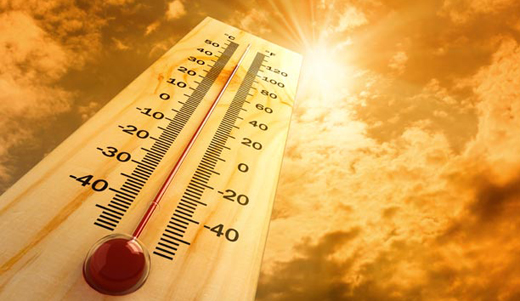Heat wave claims over 900 lives in India, Delhi records 46 degree
mangaloretoday.com
New Delhi, May 26: Heat wave that has gripped large parts of the country has killed nearly 900 people, mostly in Andhra Pradesh and Telangana, even as Delhi sizzled on Tuesday with the mercury soaring to almost 46 °C.
In Andhra Pradesh, 55 people succumbed to sunstroke while 35 more deaths were reported in Telangana.
Andhra Pradesh’s deputy chief minister N Chinna Rajappa said that 551 people had died in the state till Monday while disaster management officials in Telangana confirmed 215 deaths.

In Delhi, zebra crossings at some places melted as the India Meteorological Department (IMD) reported that the city had recorded a maximum temperature of 45.5°C.
Few people could be seen on the streets because of the oppressive heat. Even Night time temperatures hovered around the 30-degree mark.
According to the IMD, most parts of India will remain in the grip of high temperatures for the rest of the week. The department issued “red box” warnings for Odisha, Jharkhand and coastal Andhra Pradesh.
A “red box” warning usually means high chances of heatstroke, dehydration and fatality with temperatures inching upwards of 45°C and conditions worsened by a constant dry, sweltering wind.
The monsoon, expected to hit the southern coastline on May 31, is expected to bring relief from the high temperatures, officials said.
In Telangana, a maximum temperature of 44.8°C was recorded in Ramagundam city on Monday. Jangameswarapuram in Andhra Pradesh was two notches higher at 46.8°C.
A scorching sun baked northern parts and the coastal region of Karnataka with day temperatures climbing to 45°C. Kalaburagi and Bidar districts were the worst hit areas, though state capital Bengaluru is expected to have a partly cloudy sky with the possibility of rain or thunderstorm, officials said.
The heat wave was mainly triggered by an abrupt end to pre-monsoon showers and missing storms. A brewing cyclonic weather pattern in the Arabian Sea two weeks ago lost steam quickly, while depressions, or rain-causing systems, in the Bay of Bengal headed off towards the northeast states which are getting plentiful rains.
Such a weather pattern meant a large north-to-south belt – from Rajasthan to Andhra Pradesh – became home to uninterrupted “settled” weather conditions, marked by a strong, early summer sun for more than a week.
Authorities advised people to stay indoors and consume plenty of fluids, and experts warned that there could be large-scale power outages in several parts of north India if the heat wave continued, bringing back memories of a blackout in 2012 that affected nearly 600 million people.
- Mangaluru: NIA files chargesheet against 11 accused in Suhas Shetty murder case
- Mangaluru police swiftly recover Rs 17 lakh lost in digital arrest scam
- Case registered against Sharan Pumpwell for sharing objectionable post on social media
- Ivan D’Souza to file privilege motion, defamation case against Kageri and Bharath Shetty over corruption allegations on Speaker
- Mangaluru police recover 233 lost mobile phones in 45 days
- Empowering the Next Decade: Nitte University and ET Now unite to shape Karnataka’s Growth Story
- Dharmasthala mass burial case: High Court grants interim relief to Thimarodi, Mattannavar and team
- Mangaluru: Prakash Raj, Corrine Rasquinha among coastal achievers selected for Karnataka Rajyotsava Award
- Sullia: Man arrested for derogatory Facebook post against CM and Banu Mushtaq
- Ullal: Scooter rider dies after collision with private bus on NH-66
- Bantwal: Scooter rider who blocked ambulance carrying Bisle Ghat accident victims detained
- Subrahmanya: 22 injured as wedding tempo overturns near Bisle Ghat
- Bantwal: Body of missing auto driver found near Nethravathi river
- Bengaluru techie loses Rs 1.86 lakh in delivery scam, gets tile instead of phone
- Ex-Indian cricket captain Mohammad Azharuddin sworn in as minister in Telangana
- Dhyan Chand awardee and Olympics bronze medallist Manuel Frederick passes away
- Family consumes poison in Bengaluru after real-estate losses; two dead, two critical
- NDA’s Bihar election manifesto promises over 1 crore govt jobs; farm, infra among focus areas
- India beat Australia in historic chase to reach Women’s Cricket World Cup final
- Dawood Ibrahim not a terrorist: Mamta Kulkarni sparks controversy, clarifies after outrage
- Bengaluru engineering student murdered by friend over gold chain theft
- Man charred to death as car catches fire after collision with tipper lorry in Mandya
- Mumbai shocker: Man holds several children hostage over demands, detained
- Bengaluru: Caretaker heir to Rs 5 crore property Jailed for stealing gold to fund betting addiction
- RSS gets nod for march in Mallikarjun Kharge’s stronghold, but with conditions
- APD Foundation Joins WHO Civil Society Commission
- Daiva’s prediction comes true: Janardhan Reddy walks free from jail
- Skills and Competencies Take Center Stage at MSN Dialogue Series
- Court remands Maoist Lakshmi to six-day police custody
- Sandhya Shenoy honored with Society for Materials Chemistry Medal-2024
- White Cornus Apartment in Mangaluru
- City girl wins first place in state-level spell bee competition
- Alleged ‘Love Jihad’ Case in Mangaluru: Woman left home voluntarily, says police
- Girl fatally struck by reckless two-wheeler near Belman
- New residential complex for the judges inaugurated in Mangaluru
- Absconding accused nabbed after 8 years
- Truck with cylinders turns turtle in Beltangady
- Bhoota Kola artist dies of cardiac arrest
- Development of the country should be our goal: Ganesh Karnik
- Container truck gets stuck under Modankap railway bridge
- CITY INFORMATION
- TRAVEL
- TOURIST INFORMATION
- HEALTH CARE
- MISCELLANEOUS




 Write Comment
Write Comment E-Mail To a Friend
E-Mail To a Friend Facebook
Facebook Twitter
Twitter  Print
Print 

